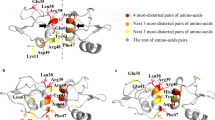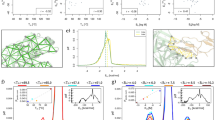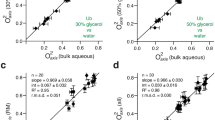Abstract
Protein structures are stabilized by hydrophobic and van der Waals forces, and by hydrogen bonds. The relation between these ther-modynamic quantities and the actual three-dimensional structure of proteins can not be calculated precisely. However, certain empirical relations have been discovered. Hydrophobic energy is gained by the reduction of surface in contact with water1. For monomeric proteins, the area of the surface accessible to solvent, and of that buried in the interior, is a simple function of molecular weight. Proteins with different shapes and secondary structures, but of the same molecular weight, have the same accessible surface area2–5. It has been argued that there is no similar relationship for large oligomeric proteins6. In this paper we show that the surface areas of oligomeric proteins, and the areas of the surface buried within them, are directly related to relative molecular mass. Although oligomers of the same molecular weight bury the same amounts of surface, the proportions buried within and between subunits vary. This has important implications for the role of subunit interfaces in the stability and activity of oligomeric proteins.
This is a preview of subscription content, access via your institution
Access options
Subscribe to this journal
Receive 51 print issues and online access
$199.00 per year
only $3.90 per issue
Buy this article
- Purchase on Springer Link
- Instant access to full article PDF
Prices may be subject to local taxes which are calculated during checkout
Similar content being viewed by others
References
1. Kauzmann, W. Adv. Protein Chem. 14, 1–63 (1959). 2. Chothia, C. Nature 254, 304–308 (1975). 3. Janin, J. /. molec. BioL 105, 13–14 (1976). 4. Teller, D. Nature 260, 729–731 (1976). 5. Miller, S., Janin, J., Lesk, A. M. & Chothia, C. J. molec. Bio/. 196, 641–656 (1987). 6. Sprang, S., Yang, D. & Fletterick, R. J. Nature 280, 333–335 (1979). 7. Bernstein, F. C. et al. J. molec. Biol. 112, 535–542 (1977). 8. Lee, B. & Richards, F. M. / molec. Biol. 55, 379–400 (1971). 9. Shrake, A. & Rupley, J. A. /. molec. Biol. 79, 351–371 (1973). 10. Jaenicke, R. Angew. Chem. 23, 395–413 (1984). 11. Privalov, P. L. Adv. Protein Chem. 33, 167–241 (1979). 12. Creighton, T. Proteins (Freeman, New York, 1983). 13. Baldwin, R. L. Proc. natn. Acad. Sci. U.S.A. 83, 8069–8072 (1986). 14. Blundell, T. L., Pitts, J. E., Tickle, I. J., Wood, S. P. & Wu, C. W. Proc. natn. Acad. Sci. U.S.A. 78, 4175–4179 (1981). 15. Mitsui, Y., Satow, Y., Watanabe, Y. & litaka, Y. /. molec. Biol. 131, 697–724 (1979). 16. Finzel, B. C., Weber, P. C., Hardman, K. D. & Salemme, F. R. /. molec. Biol. 186, 627–643 (1985). 17. Tainer, J. A., Getzoff, E. D., Beem, K. M., Richardson, D. C. & Richardson, J. S. /. molec. Biol. 160, 181–217 (1982). 18. Marquart, M., Deisenhofer, J. & Huber, R. /. molec. Biol. 141, 369–391 (1980). 19. Banner, D. W. et al. Nature 255, 609–614 (1975). 20. Ekland, H. et al. J. molec. Biol. 146, 561–587 (1981). 21. Ford, G. C., Eichele, G. & Jansonius, J. N. Proc. natn. Acad. Sci. U.S.A. 77,2559–2563 (1980). 22. Remington, S., Wiegand, G. & Huber, R. /. molec. Biol. 158, 111–152 (1982). 23. Sprang, S. & Fletterick, R. J. J. molec. Biol. 131, 523–551 (1979). 24. Terwilliger, T. C. & Eisenberg, D. /. biol Chem. 257, 6016–6022 (1982). 25. Blake, C. C. F., Geisow, M. J., Oatley, S. J., Rerat, B. & Rerat, C. /. molec. Biol. 121, 339–356 (1978). 26. Fermi, G., Perutz, M. F., Shaanan, B. & Fourme, R. /. molec. Biol. 175, 159–174 (1984). 27. Epp, O., Ladenstein, R. & Wendel, A. Eur. J. Biochem. 133, 51–69 (1983). 28. Reeke, G. N., Becker, J. W. & Edelman, G. M. J. biol. Chem. 250, 1525–1547 (1975). 29. Evans, P. R. & Hudson, P. J. Nature 279, 500–504 (1979). 30. White, J. L. et al. J. molec. Biol. 102, 759–779 (1976). 31. Biesecker, G., Harris, J. I., Thierry, J.–C. & Wonacott, A. J. Nature 266, 328–333 (1977). 32. Murthy, M. R. N., Reid, T. J., Sicignano, A., Tanaka, N. & Rossmann, M. G. / molec. Biol. 152, 465–499 (1981). 33. Blundell, T. L., Dodson, G. G., Hodgkin, D. C. & Mercola, D. Adv. Protein Chem. 26, 279–402 (1972). 34. Schirmer, T., Bode, W., Huber, R., Sidler, W. & Zuber, H. / molec. Biol. 184,251–211 (1985). 35. Stenkamp, R. E., Sicker, L. C. & Jensen, L. A. Acta crystallogr. B39, 697–703 (1983).
Author information
Authors and Affiliations
Rights and permissions
About this article
Cite this article
Miller, S., Lesk, A., Janin, J. et al. The accessible surface area and stability of oligomeric proteins. Nature 328, 834–836 (1987). https://doi.org/10.1038/328834a0
Received:
Accepted:
Issue Date:
DOI: https://doi.org/10.1038/328834a0
This article is cited by
-
Improve hot region prediction by analyzing different machine learning algorithms
BMC Bioinformatics (2021)
-
pH induced conformational alteration in human peroxiredoxin 6 might be responsible for its resistance against lysosomal pH or high temperature
Scientific Reports (2021)
-
Global analysis of protein degradation in prion infected cells
Scientific Reports (2020)
-
Identification of self-interacting proteins by integrating random projection classifier and finite impulse response filter
BMC Genomics (2019)
-
Positive functional synergy of structurally integrated artificial protein dimers assembled by Click chemistry
Communications Chemistry (2019)
Comments
By submitting a comment you agree to abide by our Terms and Community Guidelines. If you find something abusive or that does not comply with our terms or guidelines please flag it as inappropriate.



